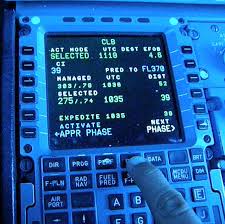How to Use a Cost Index to Your Advantage:
I had the great opportunity to fly with an instructor a couple weeks ago who was conducting training. When we pay attention lessons come from many places.

Cost Index Lesson:
Example of MCDU page values:
Cost Index UTC time /EFOB
100 1738Z / 20.9
75 1740Z / 21.2
50 1743Z / 21.9
25 1745Z / 22.0
0 1748Z / 22.1
(Flight plan cost index can be used instead, that is closest to above 25 increment C/I)
Example of MCDU page values:
Mach UTC time/ EFOB
.82M 1743Z / 21.6
.81M 1745Z / 22.2
.80M 1748Z / 22.3
.79M 1750Z / 22.2
I had the great opportunity to fly with an instructor a couple weeks ago who was conducting training. When we pay attention lessons come from many places.
Cost Index Lesson:
"The PERF descent page is hard tuned for .81/300 (variable) as I reach
top of climb, and am not expecting a change in course (this will cause a
change in fuel burns/times) all step climbs per flight plan are entered
and constant mach entries are not entered at this time for a more pure
fuel burn. I set up the following template on the right side of the
flight plan:
Example of MCDU page values:
Cost Index UTC time /EFOB
100 1738Z / 20.9
75 1740Z / 21.2
50 1743Z / 21.9
25 1745Z / 22.0
0 1748Z / 22.1
(Flight plan cost index can be used instead, that is closest to above 25 increment C/I)
Depending in your interpretation, and needs (target landing window)
Cost Index (CI) of 50 appears to give a 1000# fuel savings for an added
+5 min as compared to CI 100, and a 700# savings for only a +3 min
increase. CI of 25 and 0 do not appear to be that advantageous for the
small fuel savings regarding increased time.
After a CI is determined for the flight i.e.. 50 in this case, I go to Flt plan page and a Mach template is set up to see what computer is showing for crossing mach segment, and note the Mach/UTC/EFOB in this case .81M 1745Z / 22.2 appears to be best for this scenario:
After a CI is determined for the flight i.e.. 50 in this case, I go to Flt plan page and a Mach template is set up to see what computer is showing for crossing mach segment, and note the Mach/UTC/EFOB in this case .81M 1745Z / 22.2 appears to be best for this scenario:
Example of MCDU page values:
Mach UTC time/ EFOB
.82M 1743Z / 21.6
.81M 1745Z / 22.2
.80M 1748Z / 22.3
.79M 1750Z / 22.2
Again, depending on your interpretation and needs (target landing
window) .81M appears to be most cost effective for this flight. Also
note that there sometimes is a change in time/EFOB when a hard Mach is
entered for the constant mach segment. Trying to do better than Flight
plan values, as we know they will not be the same.
The above procedure is a little time consuming, but in most cases I have been able to average 1500 to 5000 lbs of extra fuel on arrival. I also try to climb to a higher altitude when it shows beneficial in the step climb computer."
The above procedure is a little time consuming, but in most cases I have been able to average 1500 to 5000 lbs of extra fuel on arrival. I also try to climb to a higher altitude when it shows beneficial in the step climb computer."
Enjoy the Journey!
XO Karlene

Karlene, I am a huge Boeing fan...but after reading your books and reading your posts I am starting to want to fly the A330.
ReplyDeleteThank you Jake, You will love the plane. I'm thinking you will have opportunities to fly many more inn your career too!
DeleteInteresting. Are the procedures any different on the newer A330 that Delta acquired? I would assume so since it's different engine type and Airbus probably made dozen of changes since the first one that NWA acquired.
ReplyDeleteMartin, all airlines have different procedures. Procedures are not necessarily for the equipment, some airlines even try to create similar procedures for Boeing and Airbus. So, procedures arise from the experts in the company who creates the best procedures possible. So, engine type doesn't really come into play. Typing in the various numbers will tell you what works best.
DeleteThanks for a great question!
Hey, Karlene! Just to get things into perspective: what sector length are we talking about when you say 1000 lbs savings for 5 minutes delay?
ReplyDeleteSafe flights!
Doru, I don't think he had lengths, but we were on a 10 hour flight. Definitely long haul. And while 5 minutes doesn't seem like a big deal, a 1000 pounds can be!
Delete